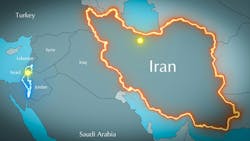Israel strikes Iran, escalating conflict and rattling energy markets
In an escalation of Middle East tensions, Israeli aircraft and drones launched early-morning strikes across Iran on Friday, targeting military and nuclear sites in what multiple sources describe as one of the most significant Israeli operations in recent years.
Reports say that Iran’s Islamic Revolutionary Guard Corps (IRGC) commanders and leading nuclear scientists and commanders have been targeted in successful attacks.
Israeli Prime Minister Benjamin Netanyahu called the strikes a last-ditch effort to prevent a nuclear-armed Iran, which Israel views as an existential threat.
The attacks follow the International Atomic Energy Agency (IAEA)’s declaration that Iran is in violation of its nuclear protocols, and come just hours after US President Donald Trump stated he was “less confident” about diplomatic efforts to contain Iran’s nuclear ambitions. Western and Israeli media have reported that the strikes were conducted with US knowledge but not with direct military support.
Global energy markets on edge
Investment bank Piper Sandler described the situation as the start of a “conventional war,” warning that the scale and intent of Israel's action far surpass past tit-for-tat skirmishes. “We doubt Iran will resort to peace talks,” their note states, pointing instead to regime survival instincts and likely retaliatory strikes. “We are not aware of any regime surviving an attack on its power structure by simply rolling over and suing for peace.”
Crude oil prices surged in early Friday trading, driven by heightened geopolitical risk premiums. While no physical oil infrastructure has been confirmed damaged in the Israeli strikes, markets are reacting to the elevated probability of regional conflict threatening critical energy supply routes.
The Strait of Hormuz—a vital chokepoint through which nearly 30% of seaborne oil and 20% of global LNG flows—remains a focal point for market fears.
“I don’t think Iran can close the Strait, but it can disrupt traffic there. If there’s any disruption in Iranian crude supply, I expect OPEC to unwind its cuts faster, which will cap the rise in crude prices. OPEC has 5-6 million b/d of spare capacity,” said Simon Wong, analyst at Gabelli Funds.
Iran currently produces around 3.2 million b/d of crude oil and over 1.5 million b/d of natural gas liquids. The global oil market may have limited spare capacity to offset potential disruptions. There is about 3 million b/d of spare oil production capacity globally—mostly concentrated in Saudi Arabia (2 million b/d), with smaller amounts in the UAE, Kuwait, and Iraq. However, all of these producers are within range of Iran’s ballistic and drone arsenal, increasing the risk to the region’s collective output, according to Piper Sandler.
LNG market
Natural gas markets, especially LNG, may face even greater exposure. “Around 20% of global LNG volumes transit the Strait of Hormuz,” said Henry Hoffman, co-portfolio manager at Catalyst Energy Infrastructure Fund.
“Over 95% of Qatari and UAE LNG exports pass through this route. Any disruption from Iranian aggression would halt shipments with no viable alternate sea route, sharply tightening global gas markets. Even a temporary shutdown, lasting weeks, would stall millions of tonnes of LNG, tighten markets, and spur sharp price shifts,” he said.
With Qatar supplying nearly 70% of its LNG to Asia and 20% to Europe, even a temporary halt could lead to shortages, disrupt supply chains, and send prices soaring.
“While oil prices have begun reflecting this risk, LNG remains more vulnerable due to its chokepoint dependency. A shutdown could spike prices in Europe and Asia, disrupt supply chains, and force a scramble for alternative volumes. This is a serious tail-risk that energy markets may not yet be fully pricing in, Europe and Asia will scramble for alternative volumes,” Hoffman warned.
However, it also underscores the strategic importance of US LNG exports. “Our ‘freedom molecules’ are looking more like global stability insurance by the day. With no singular chokepoint restrictions or geopolitical bottlenecks, American LNG offers a more secure and reliable alternative in an increasingly unstable world,” Hoffman said.
About the Author
Conglin Xu
Managing Editor-Economics
Conglin Xu, Managing Editor-Economics, covers worldwide oil and gas market developments and macroeconomic factors, conducts analytical economic and financial research, generates estimates and forecasts, and compiles production and reserves statistics for Oil & Gas Journal. She joined OGJ in 2012 as Senior Economics Editor.
Xu holds a PhD in International Economics from the University of California at Santa Cruz. She was a Short-term Consultant at the World Bank and Summer Intern at the International Monetary Fund.

